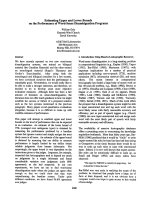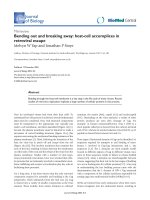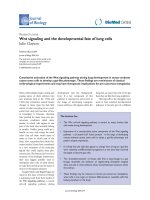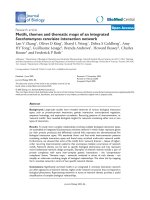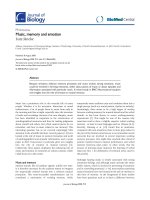Báo cáo sinh học: "Estimating variances and covariances for bivariate animal models using scaling and transformation" pot
Bạn đang xem bản rút gọn của tài liệu. Xem và tải ngay bản đầy đủ của tài liệu tại đây (503.59 KB, 10 trang )
Original
article
Estimating
variances
and
covariances
for
bivariate
animal
models
using
scaling
and
transformation
R
Thompson
RE
Crump
J Juga
PM
Visscher
2
1
Roslin
Institute
(Edinburgh)
[formerly
AFRC
Institute
of
Animal
Physiology
and
Genetics
Research
(Edinburgh
Research
Station)J,
Roslin,
Midlothian
EH25
9PS;
2
Institute
of
Cell,
Animal
and
Population
Biology,
University
of
Edinburgh,
West
Mains
Road,
Edinburgh,
EH9
3JT,
UK
(Received
4
August
1993;
accepted
1st
September
1994)
Summary -
The
estimation
of
genetic
parameters
in
bivariate
animal
models
is
consid-
ered.
It
is
shown
that
in
a
variety
of
models
the
computation
can
be
reduced
by
introducing
scaled
and
transformed
independent
traits.
This
allows
maximization
over
smaller
dimen-
sions
of
parameter
space.
In
1
numerical
example
the
procedure
reduced
the
computation
by
a
factor’of
8.
The
advantages
of
transformed
models
are
outlined.
variance
estimation
/
covariance
estimation
/
animal
model
/
transformation
*
Present
Address:
Genetics
and
Behavioural
Sciences
Department,
Scottish
Agricultural
College
Edinburgh,
West
Mains
Road,
Edinburgh,
EH9
3JG,
UK.
**
Present
Address:
The
Finnish
Animal
Breeding
Association,
PO
Box
40,
SF-01301,
Vantaa,
Finland.
t
Present
address:
Roslin
Institute
(Edinburgh),
Roslin,
Midlothian,
EH25
9PS,
UK.
Résumé -
L’estimation
des
variances
et
covariances
dans
un
modèle
individuel
à
2
caractères
après
standardisation
et
transformation
des
variables.
Cet
article
traite
de
l’estimation
des
paramètres
génétiques
dans
un
modèle
individuel
à
2
variables.
On
montre
que,
dans
beaucoup
de
situations,
le
temps
de
calcul
peut
être
diminué
en
standardisant
les
caractères
et
en
les
rendant
indépendants
par
une
transformation,
ce
qui
permet
une
maximisation
sur
un
espace
de
paramètres
de
moindre
dimension.
Un
exemple
numérique
particulier
montre
que
le
temps
de
calcul
est
divisé
par
8.
Les
avantages
des
différents
modèles
transformés
sont
présentés.
estimation
de
variance
/
estimation
de
covariance
/
modèle
animal
/
transformation
INTRODUCTION
There
is
often
the
need
for
estimation
of
genetic
and
environmental
variances
and
covariances
from
animal
breeding
data.
For
example,
to
consider
the
responses
from
alternative
selection
schemes
or
to
efficiently
predict
the
genetic
merit
of
animals.
Usually
in
animal
breeding
schemes
animals
are
selected
on
some
criteria
and
so
methods
of
analysis
are
needed
that
take
account
of
selection.
Maximum
likelihood
(ML)
methods
have
been
shown
to
take
account
of
selection
in
univariate
and
multivariate
settings
(for
example,
Henderson
et
al,
1959;
Thompson,
1973)
if
the
records
on
which
selection
is
based
are
included
in
the
data.
If
this
condition
is
only
partially
fulfilled,
ML
methods
are
less
biased
by
selection
than
analysis
of
variance
methods
(Meyer
and
Thompson,
1984).
A
restricted
or
residual
maximum
likelihood
(REML)
procedure
uses
the
likelihood
of
residuals
and
has
the
advantage
that
it
takes
account
of
the
estimation
of
fixed
effects
when
estimating
variance
components
and
corrects
for
degrees
of
freedom
(Patterson
and
Thompson,
1971).
In
general
these
methods
are
computationally
expensive
requiring
the
solution
and
inversion
of
equations
of
the
order
of
number
of
animals
x
numher
of
traits,
but
there
are
simplifications
when
all
the
traits
are
measured
on
all
auimals
and
the
same
fixed
effect
model
is
applied
to
all
traits
(Thompson,
1977:
Meyer,
1985).
In
the
past,
estimation
methods
have
used
equations
based
on
first
and
second
differentials,
but
recently
Graser
et
al
(1987)
and
Meyer
(1991)
have
shown
how
the
likelihood
can
be
calculated
recursively
in
univariate
and
multivariate
settings
and
advocated
the
direct
maximization
of
the
likelihood.
Meyer
(1991)
also
showed
that
the
computational
effort
can
be
reduced
if,
given
some
of
the
parameters,
it
is
relatively
easy
to
maximize
the
likelihood
for
the
rest
of
the
parameters.
The
maximization
then
has
2
stages
and
the
dimension
of
search
is
reduced.
Meyer
(1991)
showed
the
advantage
of
these
techniques
for
models
with
equal
design
matrices
and
3
variance
components.
In
the
recent
analysis
of
data
from
a
pig
nucleus
herd
(Crump,
1992)
we
required
to
estimate
genetic
correlations
between
male
and
female
performance
when
the
2
sexes
were
reared
in
different
environments
and
between
growth
and
reproductive
traits,
and
these
models
do
not
directly
fit
into
Meyer’s
algorithm.
In
this
paper
we
show
how
Meyer’s
method
can
be
extended
to
fit
these
and
other
models,
by
the
introduction
of
scaling
and
transformation
models.
The
models
considered
included
those
for
bivariate
traits
when
different
fixed
effect
models
are
appropriate
to
each
trait
and
to
models
with
equal
design
matrices
with
more
than
2
traits.
ESTIMATION
We
will
consider
in
turn
estimation
for
3
models.
Model
1
The
first
and
simplest
model
is
of
the
form
with
and
var(e
l)
=
10
’;1
and
var(e
2)
=
IQe2
and
el
and
e2
are
uncorrelated,
and
the
fixed
effects
#i
and
(3
2
have
no
elements
in
common,
and
the
random
effects
ui,
u2,
el
and
e2
normally
distributed.
The
vectors
Yl
and
y2
are
of
length
nl
and
n2
and
matrices
Xl,
X2,
Zl
and
Z2
are
of
size
nl
x t
l
, n
2
x
t2,
ni
x
m
and
n2
x
m.
Our
motivation
was
a
case
when
a
trait
Yl
was
measured
on
males
and
y2
was
measured
on
females
and
there
was
interest
in
the
genetic
covariance
between
traits
(0’ A12
)
and
there
was
no
environmental
covariance
between
the
records.
This
model
was
analysed
by
Schaeffer
et
al
(1978)
using
a
method
that
involved
calculation
of
the
second
differentials
of
the
likelihood
and
inversion
of
a
matrix
of
order
2m
for
each -
iteration.
If
the
2
residual
variances
are
homogeneous
then
the
univariate
method
used
by
Meyer
(1989)
can
be
used
if
the
model
is
written
in
the
form
with
If,
however,
the
residual
variances
are
not
homogeneous
the
situation
is
slightly
more
complicated.
If
ue2,
>
U;2
the
vector
of
residual
can
be
written
as
and
if
the
elements
of
the
first
vector
have
variance
0
’;
2
and
the
non-zero
elements
of
the
second
vector
variance
0
’;1
- 0’;2
then
it
is
seen
that
an
extra
component
could
be
introduced
(if
0’
;1
>
0
’;2)
and
this
component
estimated,
but
this
will
increase
the
dimension
of
the
search
by
1.
We
now
develop
a
method
that
does
not
increase
the
dimension
of
search.
It
is
useful
to
think
of
a
composite
matrix
of
yi
and
y2,
of
the
form
Y! _
[yi
Y2]
with
so
that
the
vector
of
observations
is
y
=
yi
+
y* 2
*
We
wish
to
maximize
the
log-likelihood
of
error
contrasts
(Patterson
and
Thompson,
1971).
with
í3
=
(X’V-
1
X)-
1
X’V-
ly
and
V
is
of
the
form
R+ZGZ’ =
R+Z(AxT
A
)Z’
with
x
denoting
direct
product
and
and
Then
V
=
Q[I
+
ZG
S
Z’]Q’ =
Q[I
+
Z(A
x
T
AS
)Z’]Q’ =
QHQ’ with
so
that
is
a
scaled
version
of
TA.
The
terms
in
[1]
can
be
written
in
terms
of
H,
0
&dquo;;
1’
Qe2
and
Yc
as
follows:
and
(y -
X[3)’V-
1
(y -
X#)
=
s’(Y! -
X[3!)’H 1(Y! -
X[3!)s
with
s =
1/
0’
e,
!! ! l /Ue2
_ _
with
!,,
a
matrix
of
effects
for
the
2
traits
yi,
y*
and
(Y
c
-
X(3!)’H-1 (Y! -
X#!)
a
2
x
2
matrix
of
sums
of
squares
and
cross-products
of
residuals
for
these
2
traits.
By
using
these
relationships,
and
the
formulae
for
log-likelihood
of
a
model
with
variance
matrix
H
developed
by
Graser
et
al
(1987),
it
can
be
shown
that
logL
can
be
written
using
where
df
i
=
n2
- t
i
(i
=
1,
2),
C
is
the
coefficient
matrix
of
mixed-model
equations
with
variance
matrix
I +
ZG,,Z’
and
P
=
H-
1
-
H-
1
X(X’H-
1
X)-
1
X’H-
1.
The
terms
in
C
and
P
can
be
calculated
in
an
analogous
way
to
Graser
et
al
(1987)
by
the
formation
of
M,
an
augmented
matrix
of
mixed-model
coefficients
and
right-
hand
sides
of
the
form:
with
log
ICI
associated
with
the
pivots
involved
in
the
Gaussian
elimination
of
the
terms
associated
with
X
and
Z,
and
is
the
(2
x
2)
residual
matrix
after
elimination
of
the
term
associated
with
X
and
Z.
The
term
log
[Gs[
can
be
written,
using
properties
of
direct
products
(Seaxle,
1982),
as
m
log
I T
AS
+
2
log
IAI,
with
the
last
term
independent
of
the
variance
parameters.
For
given
T
AS
,
log
L
can
be
written
as
a
function
of
terms
of
M,
a el 2
and
0
’;
2
2
using
Differentiating
this
log-likelihood
with
respect
to
0
’;1
and
Qe2,
noting
that
Gs
and
C
are
independent
of
0
’;1
and
0
’;2’
and
equating
to
zero
gives
with
the
ratio
r
=
Qei/
Qe2
satisfying
the
equation
with
df
* =
1/df
2
-
1 /df
i
and
so
and
hence
ufli
and
CT;2
can
be
found
from
[4]
and
[5]
given
the
3
parameters
in
T
AS
-
Substitution
of the
values
for
U2
e
and
CT;2
in
[3]
gives
log
L
for
given
T
AS
.
Hence
the
ML
estimates
could
be
found
with
maximization
over
the
3
parameters
in
T
AS
.
Essentially
the
structure
of
the
model
has
allowed
the
scaling
of
Yl
and
y2
by
<
7ei
and
CTe2
to
be
carried
out
independently
of
T
AS
.
Model
2
A
natural
extension
of
Model
1 is
to
allow
a
non-zero
covariance
matrix
between
the
residuals
el
and
ez,
B
CTe12
with,
for
simplicity,
the
(n
l
x
n2)
matrix
so
that
the
first
n2
animals
are
measured
on
Yl
and
y2
and
this
will
be
denoted
Model
2.
There
are
obviously
several
ways
of
writing
this
model.
We
give
below
a
form
of
this
model
that
has
2
properties.
Firstly,
this
form
allows
univariate
algorithms
to
be
used
to
calculate
likelihoods.
This
is
achieved
by
introducing
uncorrelated
effects,
Ub
,
to
help
model
covariance
effects.
Secondly,
in
order
that
scaled
versions
of
Yl
and
y2
have
homogeneous
contributions
for
el
and
e2,
as
in
model 1,
but
also
for
Ub
,
scaling
factors,
a
and
b
for
the
contributions
of
Ub
to
yi
and
y2
are
introduced.
This
model
has
the
general
form:
with
It
should
be
noted
that
the
range
of
maximization
of
o, bi 2
is
from
minus
infinity
to
infinity
rather
than
0
to
infinity
in
order
to
allow
negative
environmental
variances.
This
only
needs
minor
changes
to
the
algorithm.
The
term
log ! G !
+
log ! C !
is
normally
found
from,
say,
E
log g
i
+log
c7,
where
the
terms
gi
and
ci
are
positive.
If
ufli
is
negative
then
the
term
log
[ G
+ log
[ C
is
still
positive
definite
and
therefore
there
are
an
even
number
of
negative
terms
in g
i
and
ci
.
Therefore
log
G !
+ log ! C !
I
can
be
calculated
as
E
log
1
9i1+2:
log
I c
i
The
equivalent
residual
variance
structure
has
2
equivalent
formulations
so
the
relationships
between
the
parameters
are:
Any
non-zero
value
for
a
and
b
can
be
used
but
if
a
=
0
-:1
and
b
=
Qe2
then
the
log-likelihood
can
be
expressed
in
a
form
analogous
to
(2!
using
a
matrix
M
given
by
with
Zb
#
[ Zb21
] and
Gs
= TA
S
and
TA
= C !l ! e2 / 1
TAS
C O
l e
J
2
WIt
b21
an
S
=
AS
an
A =
<7!/
AS
0!/
Equations
[4] -
[6]
allow
estimation
of
u§f
and
Q
e2
given
T#!
and
Qbl
.
Hence
a
6
parameter
problem
has
been
converted
to
a
search
over
4
parameters.
Crump
(1992)
has
considered
extensions
of
this
model
to
allow
estimation
of
genetic
covariances
between
growth
and
reproductive
traits.
Model
3
Models
1 and 2
are
models
that
allow
different
fixed
effect
models
with
2
traits,
but
there
are
interesting
implications
if
a
similar
approach
is
applied
to
models
with
p
traits,
where
all
traits
are
measured
on
all
animals
and
the
same
fixed
effect
structure
is
applied
to
all
p
traits.
When
there
are
2
variance
component
matrices
to
be
estimated
a
canonical
transformation
to
make
the
traits
independent
can
be
useful
in
reducing
p
trait
equations
into
p
sets
of
univariate
calculations
(Thompson,
1977;
Meyer,
1985;
Taylor
et
al,
1985).
Meyer
(1991),
for
the
case
of
additive
and
residual
matrices,
has
recently
emphasized
a
2-stage
maximization
procedure,
using
S,
a
p
x
p
transformation
matrix,
and
71,
a
p
x
p
diagonal
matrix
of
canonical
heritabilities.
For
a
given
value
of
71,
the
log
likelihood
can
be
written
in
a
form
analogous
to
!2!,
with
the
use
of
p
matrices
of
the
form
of
M
and
with
Y!
an n
x
p
matrix
Y
with
the
ith
column
of
Y
the
ith
variate
yi.
Given
71,
the
log-likelihood
maximization
in
terms
of
S
is
computationally
easier,
and
in
fact
when
p
=
2
there
is
an
explicit
estimate
of
S
in
terms
of
the
residual
matrices
(Juga
and
Thompson,
1992).
On
a
small
numerical
example
Meyer
(1991)
has
reduced
computation
to
a
half
by
such
a
technique
and
one
would
expect
larger
savings
as
p
increased.
For
more
than
2
sets
of
components,
there
is
a
natural
extension
of
Meyer’s
method
and
the
method
used
for
Models
1 and
2.
To
illustrate
the
method
suppose
3
symmetric
(2
x
2)
matrices
E,
TA
and
TB
require
estimation
and
the
variance
matrix
is
With
2
components
a
transformation
to
simultaneously
diagonalize
the
variance
matrices
is
available,
but
not
generally
for
more
than
2
components.
However,
there
is
a
transformation
S(=
Q-
1)
such
that
SES’
=
I,
ST
B
S’
=
T
BS
and
ST
A
S’
=
T
AS
with
T
BS
a
diagonal
matrix.
When
p
=
2,
the
3
x
3
=
9
parameters
in
E,
TA
and
TB
can
therefore
be
written
in
terms
of
the
4
parameters
in
S,
2
in
T
BS
and
3
in
T
AS
.
The
calculation
of the
log
likelihood
is
now
based
on
a
composite
p
x
p2
matrix
Yc.
This
matrix
has
p2
variates
formed
from
the
direct
product
of
the
p
x
p
identity
matrix
and
Y,
the n
x
p
matrix
of
observations
with
each
column
representing
a
trait.
The
log
likelihood
can
be
calculated
using
a
formula
similar
to
!2!,
and
it
can
be
seen
that
Yc
includes
the
variates
used
in
Models
1
and 2
and
expands
the
matrix
Y
used
by
Meyer
(1991)
when
estimating
2
components.
The
log
likelihood
in
this
case
is
similar
to
[2]
of
the
form:
with
Gs
=
A
x
T
AS
Bs
=
B
x
T
BS
and
!C!
found
from
[7]
with
I(1/
Qb
)
replaced
by
BS 1.
The
(1
x
p2)
vector
s’
is
found
by
stacking
the
rows
of
S
into
a
vector,
ie
s!i_1!P+!
=
Sij.
The
term
Y’PY,
=
U
can
be
found
from
the
residual
sum
of
squares
and
cross-product
residual
matrix
for
the
p2
variates
in
Yc
after
adjusting
for
all
the
effects.
Differentiation
of
[10]
with
respect
to
S
shows
that
the
estimates
of
S
that
maximize
[8]
for
given
values
of
T
AS
and
T
BS
satisfy
with
si! _
(S
-’)
ij
.
The
appendix
shows
that
S
can
be
found
as
the
solution
of
an
eigenvalue
problem
if p = 2.
Hence
if p =
2 maximization
can
be
reduced
from
considering
9
parameters
to
a
search
over
the
5
dimensional
space
of
T
AS
and
T
BS
.
Meyer
(1991)
illustrated
her
methods
with
data
from
a
selection
experiment
of
Sharp
et
al
(1984)
and
fitted
a
3-component
model
to
bivariate
data.
The
likelihood
was
maximised
over
a
9
dimensional
space
and
required
722
iterations
to
reach
con-
vergence.
Using
the
same
starting
values
and
convergence
criteria
the
5
dimensional
strategy
outlined
in
this
section
reached
convergence
in
89
evaluations.
DISCUSSION
It
has
been
shown,
for
a
variety
of
models,
how
scaling
and
transformation
can
reduce
the
considerable
effort
in
finding
maximum
likelihood
estimates,
especially
for
multivariate
models.
Another
advantage
is
that
the
transformation
can
suggest
more
parsimonious
models.
For
example,
one
could
consider
a
constrained
model
of
the
form:
SES’
=
I,
STBSS’
=
TB
and
STASS’
=
TA
with
T
AS
and
T
BS
diagonal,
that
is
fitting
a
model
with
underlying
uncorrelated
traits
that
are
transformed
using
Q
=
S-’
to
form
the
p
measured
traits.
This
model
has
the
advantage
of
having
fewer
parameters
(p(p
-E- 2))
and
that
the
likelihood,
for
given
T
BS
and
T
AS
,
can
be
calculated
in
about
(1/p
2)
of
the
time
of
the
unconstrained
model
because
the
likelihood
of
each
underlying
trait
can
be
calculated
separately.
For
Meyer’s
example
an
underlying
uncorrelated
model
converged
in
50
iterations.
The
difference
in
2
log
L
was
0.94
suggesting
that
an
underlying
independent
model
would
adequately
fit
the
data.
Lin
and
Smith
(1990)
have
pointed
out
that
by
transforming
to
these
approximately
uncorrelated
traits,
simpler
best
linear
unbiased
predictors
can
be
obtained.
Villanueva
et
al
(1993)
have
given
examples
where
this
procedure
has
very
high
efficiency.
The
strategy
outlined
gives
a
logical
method
for
choosing
the
transformation
S.
In
the
multivariate
case
S
can
be
found,
for
given
T
AS
and
T
BS
,
by
derivative-
free
methods
but
the
explicit
solution
for
p
=
2
has
advantages.
In
fact
for
the
numerical
example
above
at
the
maximum
likelihood
estimates
for
T
AS
and
T
BS
,
2
of
the
solutions
of
[8]
for
S
correspond
to
local
maxima
and
2
to
saddlepoints.
Explicit
solutions
for
S
if
p
>
2
were
not
obtained
and
the
best
computational
strategy
in
terms
of
derivative-free
methods
or
iterative
use
of
[8]
or
solutions
for
p
=
2
deserves
further
investigation.
The
motivation
has
been
to
reduce
the
computation
in
derivative-free
estimation
procedure,
but
the
idea
of
scaling
and
transformation
carries
over
to
other
methods
of
estimation,
for
example,
using
first
and/or
second
differentials
of
likelihoods.
Formulae
for
derivatives
of
the
scaled
parameters
T
AS
,
T
BS
,
are
easily
derived
if
not
easily
calculated,
for
a
given
transformation
matrix
S.
The
arguments
in this
paper
show
how
to
calculate
derivatives
for
any
S.
This
allows
for
any
T
AS
and
T
BS
,
S
to
be
found
using
the
derivatives
calculated
at
this
optimal
S.
The
efficiency
of
this
technique
will
depend
on
the
structure
of
the
data
and
the
correlation
of
the
parameters
and
deserves
further
investigation.
If,
after
fitting
this
underlying
model,
there
is
interest
in
getting
some
infor-
mation
on
covariances
between
the
underlying
traits
but
full
p
trait
evaluation
is
impractical,
then
use
of
the
Thompson
and
Hill
(1990)
procedure
to
estimate
co-
variance
parameters
from
analysis
of
sums
of
approximately
independent
traits
is
an
attractive
option.
REFERENCES
Crump
RE
(1992)
Quantitative
genetic
analysis
of
a
commercial
pig
population
undergoing
g
selection.
PhD
Thesis,
University
of
Edinburgh,
UK
Graser
HU,
Smith
SP,
Tier
B
(1987)
A
derivative-free
approach
for
estimating
variance
components
in
animal
models
by
restricted
maximum
likelihood.
J
Anim
Sci
64,
1362-
1370
Henderson
CR,
Kempthorne
0,
Searle
SR,
Von
Korsegk
CM
(1959)
Estimation
of
environmental
and
genetic
trends
from
records
subject
to
culling.
Biometrics
13,
192-
218
Juga
J,
Thompson
R
(1992)
A
derivative-free
algorithm
to
estimate
bivariate
(co)variance
components
using
canonical
transformations
and
estimated
rotations.
Acta
Agric
Scand
A
42,
191-197
Lin
CY,
Smith
SP
(1990)
Transformation
of
multitrait
to
unitrait
mixed
model
analysis
of
data
with
multiple
random
effects.
J
Dairy
Sci
73,
2494-2502
Meyer
K
(1985)
Maximum
likelihood
estimation
of
variance
components
for
a
multivariate
mixed
model
with
equal
design
matrices.
Biometrics
41,
153-165
Meyer
K
(1989)
Restricted
maximum
likelihood
to
estimate
variance
components
for
animal
models
with
several
random
effects
using
a
derivative-free
algorithm.
Genet
Sel
Evol 21,
317-340
Meyer
K
(1991)
Estimating
variance
and
covariances
for
multivariate
animal
models
by
restricted
maximum
likelihood.
Genet
Sel
Evol 23,
67-83
Meyer
K,
Thompson
R
(1984)
Bias
in
variance
and
covariance
component
estimation
due
to
selection
on
a
correlated
trait.
Z
Tierz
Zuchtungsbiol
101,
33-50
Patterson
HD,
Thompson
R
(1971)
Recovery
of
inter-block
information
when
block
sizes
are
unequal.
Biorn,etrika
58,
545-554
Schaeffer
LR,
Wilton
JW,
Thompson
R
(1978)
Simultaneous
estimation
of
variance
and
covariance
components
from
multitrait
mixed
model
equations.
Biometrics
34,
199-208
Searle
SR
(1982)
Matrix
Algebra
Useful
for
Statistics.
John
Wiley
and
Sons,
NY,
USA
Sharp
GL,
Hill
WG,
Robertson
A
(1984)
Effects
of
selection
on
growth,
body
composition,
and
food
intake
in
mice.
I
Response
in
selected
traits.
Genet
Res
43,
75-93
Taylor
JF,
Bean
B,
Marshall
CE,
Sullivan
JJ
(1985)
Genetic
and
environmental
compo-
nents
of
semen
production
traits
of
artificial
insemination
Holstein
bulls.
J
Dairy
Sci
68,
2703-2722
Thompson
R
(1973)
The
estimation
of
variance
and
covariance
components
with
an
application
when
records
are
subject
to
culling.
Biometrics
29,
527-550
Thompson
R
(1977)
Estimation
of
quantitative
genetic
parameters.
In:
Proc
Int
Co!.f
Quant
Genet
639-657,
Iowa
State
Press,
Ames,
IA,
USA
Thompson
R,
Hill
WG
(1990)
Univariate
REML
analyses
for
multivariate
data with
the
animal
model.
In:
Proc
Fourth
World
Congr
Genet
Appl
Livest
Prod
(WG
Hill,
R
Thompson,
JA
Woolliams,
eds)
13, 484-487
Villanueva
B,
Wray
NR,
Thompson
R
(1993)
Prediction
of
asymptotic
rates
of
response
from
selection
on
multiple
traits
using
univariate
and
multivariate
best
linear
unbiased
predictors.
Ani!a
Prod
57,
1-13
APPENDIX
Solution
of
equation
!11!
When
p
=
2
equation
!11!
can
be
written
as
or
or
This
equation
is
similar
to
equations
relating
the
ith
eigenvector x
i
and
the
ith
eigenvalue
Ai
of
F
and
U,
ie
Fx
i
=
AjUx
i.
For
a
given
eigenvector
xz
with
eigenvalue
Ai
a
scaled
vector
kixi
will
satisfy
[Al]
if
so
(xi
lx
24
-xi
2
xi
3
)k2
=
!2,
and
so
a
scaled
vector
of x
i
can
be
found
to
satisfy
[Al]
as
a
function
of
xz
and
Aj .
Hence
4
vectors
Si
can
be
calculated
to
satisfy
[11].
Each
vector
can
be
substituted
into
!11!
in
order
to
find
S
to
maximize
!10!.
This
result
can
be
thought
of
as
a
generalization
of
result
[3]-[5]
for
Model
1 and
the
result
of
Juga
and
Thompson
(1992)
for
2
components.
In
the
first
case
U
is
of
the
form:
and
in
the
second:
